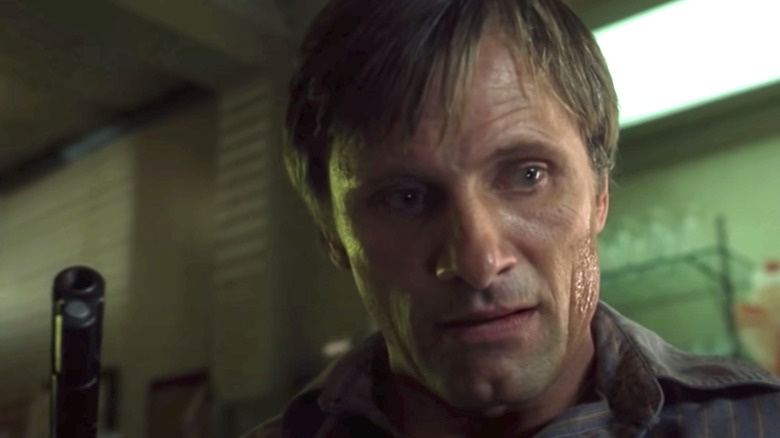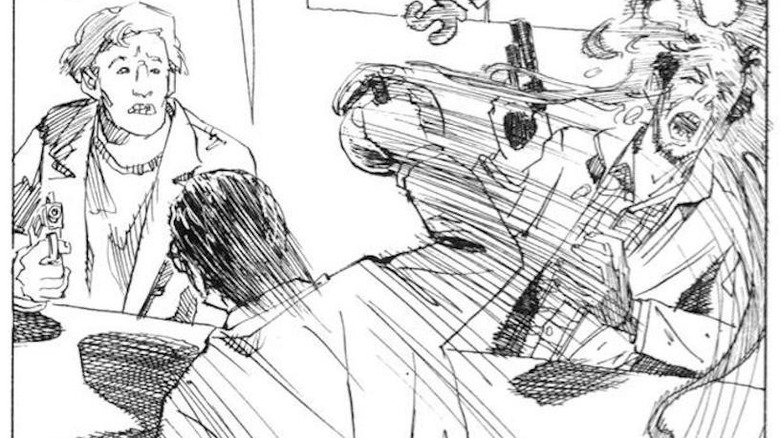The Viggo Mortensen Drama You Likely Didn't Know Was Based On A Graphic Novel
There are two types of movie fans in the world — those who read about a new David Cronenberg film and get excited to see what fresh body horrors the legendary director has in store, and those who twinge at the mere mention of a new film from the notorious shockteur. To be clear, there's really not a right or wrong side of that coin. The filmmaker's boundary-destroying cinematic oeuvre is, after all, sort of designed to horrify as much as it is to engage viewers on a visceral emotional level. And whatever you think of films like "The Fly" and "Scanners," Cronenberg has routinely succeeded in accomplishing his goals throughout his decades-long career.
That's been as true of Cronenberg's four masterful collaborations with Viggo Mortensen as with any other films in the director's body of work. Of those offerings, the biographical drama "A Dangerous Method," the bruising Russian gangster flick "Eastern Promises," and the surgery-as-performance-art thriller "Crimes of the Future" obviously provided the pair with ample opportunity to test the wills and wits of even their most steadfast fans.
The same could be said — albeit, to a slightly lesser degree — of the duo's first collaboration, a slow-burning Middle America crime drama that you likely didn't know was based on a graphic novel.
A History of Violence is actually based on a classic graphic novel from Vertigo
The film in question is the 2005 crime thriller "A History of Violence," which was adapted from a graphic novel of the same name. The book was first published in 1997 via DC Comics' now defunct Vertigo imprint, and it remains one of the strongest offerings in the Vertigo vaults.
As for the movie, the pulse-pounding thriller — about an average Midwesterner named Tom Stall whose life unravels after brutally defending his small-town diner from a pair of violent thugs — is arguably the best of Cronenberg's collaborations with Viggo Mortensen to date, with the actor himself telling The Hollywood Reporter in 2014 he believes it's one of the best film's he's ever been in.
If you've seen (or read) "A History of Violence," you know there's more to Tom's story than meets the eye. Mortensen is at his nuanced best here, plumbing the depths of despair and unholy menace as Tom's past comes shockingly into focus. For his part, Cronenberg lets the action unfold with the unnerving resolve of a voyeur watching a car crash in slow-motion. What they conjure in the mix is a stylish, soul-piercing crime drama rife with all the physical, psychological, and emotional carnage you'd expect from a Cronenberg film wrapped in a low-key action movie bow. This delivers a film Collider ranks among the best graphic novel adaptations ever made.
In a funny twist of fate, David Cronenberg apparently isn't sure he actually did adapt a graphic novel, with the auteur telling Movieweb in 2005, "I didn't know anything about the source material. I ended up really treating this like it was an original screenplay, so I can't really say that I've done an adaptation of a graphic novel."
Cronenberg's A History of Violence is quite different from the comics
David Cronenberg's comments on his "adaptation" of "A History of Violence" are about as on brand as you can get for the arthouse icon. And the version of the film moviegoers saw is actually quite different from the one released by Vertigo. That's because screenwriter Josh Olson took more than a few liberties with the more plot-driven, action-forward source material in his Oscar-nominated adaptation (per Cinephilia and Beyond). In an interview with The Huffington Post, Olson spoke frankly about his dramatically different approach to the material, offering, "With 'History,' I took John Wagner's premise, title, and [...] 'inciting incident,' and then leapt off and told my own story. I was more interested in getting into questions of identity."
Indeed, the "inciting incident" in the diner unfolds almost exactly the way it does in the book. But from there, Olson largely eschews the book's plot-heavy story in service of a character-first approach. Specifically, said approach led the scribe to delay the reveal about Tom (covered early in the novel) until much later in the film. Per Olson, the change provided, in his words, "a great chance to play with a classic 'wrong man' scenario in which the wrong man is actually the right man."
Olson further claims the change led him to dig deep in exploring the film's central quandary of whether Tom's attempt to recreate himself could ever truly be successful. Said question becomes the driving force behind the film, and it helps paints a startling portrait of a man whose shifty identity, violent tendencies, and dodgy mythology mirrors that of America itself. It's a complex portrait some won't be comfortable gazing upon — and that's precisely the point.


